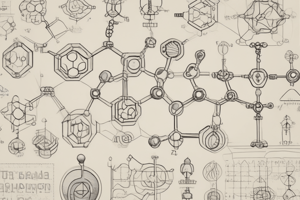Podcast
Questions and Answers
What is the common element found in all organic compounds?
What is the common element found in all organic compounds?
- Nitrogen
- Oxygen
- Carbon (correct)
- Hydrogen
What is the main characteristic of saturated hydrocarbons?
What is the main characteristic of saturated hydrocarbons?
- They have triple bonds between carbon atoms
- They have double bonds between carbon atoms
- They have only single bonds between carbon atoms (correct)
- They have a planar ring structure
Which functional group is found in amines?
Which functional group is found in amines?
- Amino (-NH2) group (correct)
- Carboxyl (-COOH) group
- Methyl (-CH3) group
- Hydroxyl (-OH) group
What is the definition of biomolecules?
What is the definition of biomolecules?
What is the characteristic of aromatic hydrocarbons?
What is the characteristic of aromatic hydrocarbons?
What is isomerism?
What is isomerism?
What type of biomolecule provides energy and structure for cells?
What type of biomolecule provides energy and structure for cells?
What is the characteristic of unsaturated hydrocarbons?
What is the characteristic of unsaturated hydrocarbons?
Flashcards are hidden until you start studying
Study Notes
Organic Compounds
- Definition: Organic compounds are carbon-based compounds that contain hydrogen and may contain other elements such as oxygen, nitrogen, and sulfur.
- Characteristics:
- Typically have a low melting point and boiling point
- Are often insoluble in water
- Can be found in living organisms and fossil fuels
Functional Groups
- Definition: Functional groups are specific groups of atoms that determine the chemical properties of an organic compound.
- Examples:
- Hydroxyl (-OH) group: found in alcohols
- Carboxyl (-COOH) group: found in carboxylic acids
- Amino (-NH2) group: found in amines
- Methyl (-CH3) group: found in many organic compounds
Hydrocarbons
- Definition: Hydrocarbons are organic compounds that consist only of hydrogen and carbon atoms.
- Types:
- Saturated hydrocarbons (alkanes): have only single bonds between carbon atoms
- Unsaturated hydrocarbons (alkenes and alkynes): have one or more double or triple bonds between carbon atoms
- Aromatic hydrocarbons: have a planar ring structure with alternating double bonds
Biomolecules
- Definition: Biomolecules are organic compounds that are found in living organisms.
- Types:
- Carbohydrates: provide energy and structure for cells (e.g. glucose, cellulose)
- Proteins: perform a wide range of functions in cells (e.g. enzymes, hormones)
- Lipids: provide energy and structure for cells (e.g. fats, oils)
- Nucleic acids: contain genetic information (e.g. DNA, RNA)
Isomerism
- Definition: Isomerism is the phenomenon of having two or more compounds with the same molecular formula but different structures.
- Types:
- Structural isomerism: different bond connections between atoms
- Stereoisomerism: different spatial arrangements of atoms in space
Reactions
- Types:
- Combustion reactions: involve the reaction of an organic compound with oxygen to produce heat and light
- Synthesis reactions: involve the formation of a new compound from smaller molecules
- Decomposition reactions: involve the breakdown of a compound into smaller molecules
Organic Compounds
- Are carbon-based compounds that contain hydrogen and may contain other elements such as oxygen, nitrogen, and sulfur.
- Typically have a low melting point and boiling point.
- Are often insoluble in water.
- Can be found in living organisms and fossil fuels.
Functional Groups
- Are specific groups of atoms that determine the chemical properties of an organic compound.
- Hydroxyl (-OH) group is found in alcohols.
- Carboxyl (-COOH) group is found in carboxylic acids.
- Amino (-NH2) group is found in amines.
- Methyl (-CH3) group is found in many organic compounds.
Hydrocarbons
- Are organic compounds that consist only of hydrogen and carbon atoms.
- Saturated hydrocarbons (alkanes) have only single bonds between carbon atoms.
- Unsaturated hydrocarbons (alkenes and alkynes) have one or more double or triple bonds between carbon atoms.
- Aromatic hydrocarbons have a planar ring structure with alternating double bonds.
Biomolecules
- Are organic compounds that are found in living organisms.
- Carbohydrates provide energy and structure for cells (e.g. glucose, cellulose).
- Proteins perform a wide range of functions in cells (e.g. enzymes, hormones).
- Lipids provide energy and structure for cells (e.g. fats, oils).
- Nucleic acids contain genetic information (e.g. DNA, RNA).
Isomerism
- Is the phenomenon of having two or more compounds with the same molecular formula but different structures.
- Structural isomerism involves different bond connections between atoms.
- Stereoisomerism involves different spatial arrangements of atoms in space.
Reactions
- Combustion reactions involve the reaction of an organic compound with oxygen to produce heat and light.
- Synthesis reactions involve the formation of a new compound from smaller molecules.
- Decomposition reactions involve the breakdown of a compound into smaller molecules.
Studying That Suits You
Use AI to generate personalized quizzes and flashcards to suit your learning preferences.




